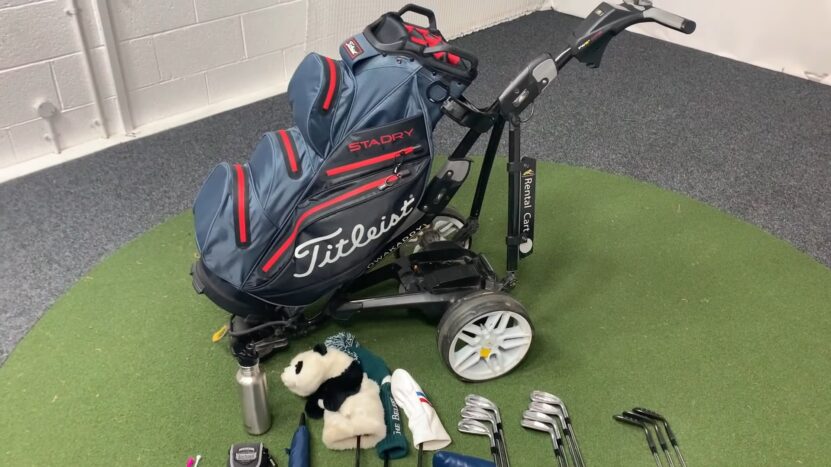A golf bag is not just a caddy for your clubs; it’s the command center for your game. Knowing how to organize your golf bag efficiently is crucial for a seamless game, and in this guide, we will walk you through various options, namely 14-way, 8-way, 6-way, and 4-way, ensuring you find a method that suits your playing style and preferences.
Golf Bag Dividers: The Basics
To initiate, understanding the essentials of golf bag dividers is imperative. Dividers are the compartments in your golf bag that hold your clubs, and they range from 4-way to 14-way, referring to the number of individual sections available.
Why Dividers Matter
Dividers play a pivotal role in the game of golf, ensuring that your clubs are well-organized, easily accessible, and protected from damage.
- Organization and Accessibility: A well-organized golf bag allows you to quickly locate and retrieve the club you need, optimizing your game’s flow and reducing frustration.
- Protection: The dividers prevent your clubs from rubbing against each other, reducing wear and the risk of damage.
Types of Dividers
Before choosing a divider, identifying the types is essential.
- Full-Length Dividers: These extend the full length of the bag, keeping your clubs separate and preventing them from touching.
- Top Dividers: They only segregate the clubs at the top of the bag, leaving the shafts to mingle, which can lead to clattering and potential damage.

Organizing a 14-Way Golf Bag
A 14-way golf bag has individual slots for each club, providing maximum organization and protection. It’s ideal for those who carry a full set of clubs and prefer meticulous organization.
The Layout Strategy
When organizing these, positioning is crucial.
- Top Row: Place longer clubs like drivers and woods, allowing for easy access and preventing them from interfering with shorter clubs.
- Middle Rows: Position your irons in descending order from left to right or vice versa, depending on your preference.
- Bottom Row: Allocate this space for shorter clubs like wedges and your putter.
Balancing the Weight
Balancing the weight in a 14-way bag is crucial to prevent strain during the game.
- Distribute Evenly: Place heavier clubs opposite to each other to maintain balance. Ensure the weight is symmetrically distributed around the bag’s spine.
- Utilize Pockets Wisely: Store your accessories, balls, and other items in the side pockets, keeping the weight evenly spread and avoiding any unnecessary load on one side.

Setting Up an 8-Way Golf Bag
An 8-way golf bag is versatile and accommodative, ideal for players who don’t mind their clubs mingling a bit but still value some level of organization and quick access.
Arranging Clubs Methodically
With an 8-way divider, thoughtful arrangement is key.
- Top Section: Reserve for your drivers and woods, avoiding clutter with shorter clubs.
- Middle Section: Here, your mid-range irons find their place. Keep them in sequential order for easy retrieval.
- Bottom Section: This is where your shorter clubs, like the wedges and putter, should be stationed.
Efficient Use of Space
In these, maximizing available space is crucial.
- Avoid Overcrowding: Despite the temptation to carry many clubs, try to stick to the essentials to avoid overcrowding and ease accessibility.
- Strategic Pocket Use: Utilize pockets for storing balls, gloves, and other accessories, ensuring that they are spread out to maintain balance in the bag.
Managing a 6-Way Golf Bag

A 6-way golf bag is a good compromise between organization and simplicity, offering enough dividers for basic arrangement while keeping the setup uncomplicated.
Strategic Club Placement
In these, strategic placement of clubs is paramount.
- Top Compartments: Designated for longer clubs like drivers and fairway woods.
- Middle Compartments: Ideal for your irons, keeping them in descending order for convenient access.
- Lower Compartments: This is where your shortest clubs, including the wedges and the putter, should reside.
Optimal Weight Distribution
Proper weight distribution is vital in a 6-way golf bag to ensure comfort and ease of access.
- Even Distribution: Place heavier clubs strategically to avoid imbalance, potentially causing strain during play.
- Balance Accessories: Distribute accessories and additional items evenly across the pockets to maintain balance and avoid undue pressure on one side of the bag.
Organizing a 4-Way Golf Bag

A 4-way golf bag is for those who prefer simplicity and minimalism. It provides basic organization without the frills, making it lightweight and straightforward.
Club Arrangement in Limited Space
With limited space, intelligent arrangement of clubs is crucial in a 4-way golf bag.
- Upper Section: Reserved for your longest clubs like the driver and fairway woods.
- Lower Sections: Accommodate your irons, wedges, and putter, arranged in a way that allows easy identification and access.
Maximizing Space and Balance
In these, maximizing the available space efficiently and maintaining balance is crucial.
- Avoid Overpacking: Stick to essential clubs to prevent overcrowding and maintain easy access to each.
- Distribute Weight: Arrange accessories and additional items in a way that the weight is evenly distributed, preventing strain and ensuring comfort during the game.
Choosing the Right One

When selecting a golf bag, considering your individual needs, playing style, and personal preferences is crucial. The right bag will not only accommodate your clubs but also enhance your playing experience.
Analyzing Your Needs
Understanding your specific needs and preferences is pivotal when choosing a golf bag.
- Assess Your Club Collection: Those with a larger collection of clubs might prefer a 14-way golf bag for maximum organization, while casual players may opt for simpler 4 or 6-way bags.
- Consider Your Playing Style: Frequent players might need more storage for accessories and might benefit more from a bag with more dividers and pockets.
Evaluating Features and Comfort
Comfort and additional features should also play a significant role in your decision.
- Comfort and Portability: Consider the bag’s weight, strap system, and handle design to ensure carrying comfort.
- Extra Features: Assess additional features like cooler pockets, full-length dividers, and rain hoods, depending on your needs and preferences.
Maintenance and Care
Preserving your golf bag’s longevity requires regular maintenance and proper care. A well-maintained one will not only look good but will also protect your precious clubs.
Regular Cleaning
Regular cleaning is essential to maintain your golf bag’s condition.
- Empty It Completely: Remove all clubs and items from the pockets and shake out any debris.
- Use Mild Soap and Water: Clean the exterior and interior with a gentle soap solution and a soft brush or cloth, focusing on dirty and stained areas.
Proper Storage
Storing your golf bag correctly will prevent damage and wear over time.
- Store in a Cool, Dry Place: Avoid exposure to extreme temperatures and humidity, which can damage the material of the bag and the clubs.
- Keep it Upright: Store your golf bag in an upright position to maintain its shape and structure and to prevent any stress on the dividers and pockets.
FAQs
How do I decide between a cart and a stand bag?
The choice between these largely depends on your mode of play. If you usually ride a cart, a cart variation, which is larger and has more storage but is also heavier, might be more suitable.
If you walk the course and carry your bag, a lighter and more ergonomic stand variation would be ideal, as it has built-in legs to stand upright on the course.
Is it necessary to have a rain hood for my golf bag?
While not strictly necessary, a rain hood is a beneficial accessory, especially in unpredictable weather, as it protects your clubs and belongings from water damage. It’s particularly useful for those who play in regions with frequent rainfall.
How important is the weight of the golf bag when organizing my clubs?
The weight is crucial, especially if you prefer walking the course. A lighter bag reduces strain on your back and shoulders. Additionally, a well-balanced one, where weight is evenly distributed, makes carrying more comfortable and reduces the risk of injury.
Can I have a customized divider setup in my golf bag?
Yes, many brands offer customization options or have specific models with adjustable dividers, allowing you to organize your clubs in a way that suits your preferences and playing style. However, customized or adjustable divider setups may come at an additional cost.
How often should I clean my golf bag?
Regular cleaning is advisable, but the frequency depends on your usage. If you play often, especially in muddy or damp conditions, cleaning your bag every few weeks is beneficial.
For occasional golfers, cleaning it once every couple of months or as needed should suffice.
What should I do if the dividers in my golf bag wear out or get damaged?
Some high-quality golf bags offer replaceable dividers. If replacement is not an option, you might consider getting one with more durable, full-length dividers in your next purchase.
Regular cleaning and proper storage can also prolong the life of the dividers. If damage occurs, consult the manufacturer for possible solutions or repairs.
Final Words
No matter the divider configuration you choose, thoughtful organization and weight distribution are key to a seamless golfing experience. From the meticulous 14-way to the straightforward 4-way, each setup offers unique benefits catering to different preferences and playing styles.
Whether you’re a seasoned pro or a casual enthusiast, an organized golf bag will elevate your game and allow you to focus on perfecting your swing.

